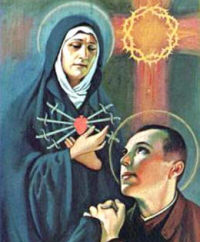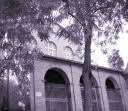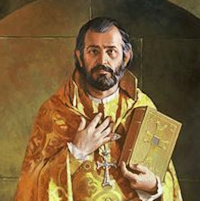Lent: February 27th
Saturday of the First Week of Lent; Optional Memorial St. Gregory of Narek, abbot & doctor of the Church
Other Commemorations: St. Gabriel of Our Lady of Sorrows, Acolyte (RM)
Free eBook:

|
| Free eBook: Breaking Free |
» Enjoy our Liturgical Seasons series of e-books!
On February 2, 2021, Pope Francis decreed that St. Gregory of Narek be added to the General Roman Calendar. St Gregory of Narek, Doctor of the Church, Armenian monk, poet, mystical philosopher, theologian, writer and saint of the Armenian Apostolic Church and Catholic Church was born into a family of writers. Based in the monastery of Narek (Narekavank), he was “Armenia’s first great poet” and as “the watchful angel in human form”.
According to the 1962 Missal of St. John XXIII the Extraordinary Form of the Roman Rite, today is the feast of St. Gabriel of Our Lady of Sorrows who was born in Assisi on March 1, 1838, the eleventh child of Sante Possenti and Agnes Frisciotti. His father Sante was a distinguished Italian lawyer. The boy was given the name of the city's illustrious patron, St. Francis, at baptism.
According to the Roman Martyrology, today is the feast of St. Leander, bishop of Seville in Spain, brother of St. Isidore and St. Florentina, who converted the Visigoths from the Arian heresy to the Catholic faith.
St. Gregory Narek
 St. Gregory was born in the city of Narek about 950 A.D. He was a monk, poet, mystical philosopher, and theologian, born into a family of writers. St. Gregory received his education under the guidance of his father, Bishop Khosrov, author of the earliest commentary on the Divine Liturgy, and from Anania Vartabed, Abbot of Nareg Monastery. He and his two brothers entered monastic life at an early age.
St. Gregory was born in the city of Narek about 950 A.D. He was a monk, poet, mystical philosopher, and theologian, born into a family of writers. St. Gregory received his education under the guidance of his father, Bishop Khosrov, author of the earliest commentary on the Divine Liturgy, and from Anania Vartabed, Abbot of Nareg Monastery. He and his two brothers entered monastic life at an early age.
He became a priest at the age of 25 and dedicated himself to God completely, always searching for the truth. Most of his life he lived in the monasteries of Narek where he taught at the monastic school. He launched his writings with a commentary on the “Song of Songs,” which was commissioned by an Armenian prince. Despite his reservations that he was too young for the task, he wrote the commentary, which is famous for its clarity of thought and language, and its excellence of theological presentation.
He also wrote a number of famous letters, sharagans, treasures, odes, melodies, and church writings. However, his masterpiece is considered to be his Book of Lamentations, commonly called “Narek,” in which his genius is displayed. (This work, published in 1673 in Marseille, has been translated into at least 30 languages.) Also known as The Prayer Book, it is described by St. Gregory as his last testament: “Its letters like my body, its message like my soul.” He called his book an “encyclopedia of prayer for all nations.” It was his hope that it would serve as a guide to prayer by people of all stations around the world.
St. Gregory of Narek is considered the greatest poet of the Armenian nation and its first and greatest mystic. His writing style and command of the Armenian language are unparalleled, and his saintly person has been an inspiration to the Armenian faithful for centuries. St. Gregory’s poetry is deeply biblical and is filled with images and themes of sacred history, while also distinguished with an intimate and personal character. Numerous miracles and traditions have been attributed to him and he is referred to as “the watchful angel in human form.” St. Gregory died in 1003 A.D.
St. Gregory of Narek was proclaimed a Doctor of the Universal Church on April 12, 2015 by Pope Francis. On February 2, 2021, his optional memorial was inscribed on the General Roman Calendar for February 27.
Highlights and Things to Do:
- Watch this video about the life of St. Gregory Narek here.
- Read the Decree inscribing this feast in 2021 in the General Roman Calendar.
- Read more about St. Gregory of Narek:
- Purchase a copy of The Armenian Prayer Book of St. Gregory of Narek.
- Gregory was buried inside the walls of the monastery of Narek. A rectangular-shaped chapel-mausoleum was built on his tomb, which survived until the mid-20th century, when the monastery, abandoned in the aftermath of the Armenian genocide, was destroyed by the Turkish authorities, and later replaced with a mosque. (See Wikipedia for references.
St. Gabriel of Our Lady of Sorrows
 On Ascension Day, 1920, Pope Benedict XV bestowed the honors of sainthood on a youth who is rightly called the Aloysius of the 19th century. He was Francis Possenti, known in religion as Gabriel of the Sorrowful Mother.
On Ascension Day, 1920, Pope Benedict XV bestowed the honors of sainthood on a youth who is rightly called the Aloysius of the 19th century. He was Francis Possenti, known in religion as Gabriel of the Sorrowful Mother.
Born in Assisi, March 1, 1838, he was given the name of the city's illustrious patron, St. Francis, at baptism. As a student in neighboring Spoleto, he led a good though rather worldly kind of life until God drew him closer to Himself through an illness. The decisive step was taken while seeing the highly honored miraculous picture of our Lady in Spoleto borne about in solemn procession. As his eyes followed our Blessed Mother, Francis felt the fire of divine love rising in his heart and almost at once made the resolve to join the Passionists, a religious congregation dedicated to the veneration of and meditation on the passion of Jesus Christ (1856).
After overcoming many difficulties, he carried out his resolution and received the religious name, Gabriel of the Mother of Sorrows. Even as a novice, he was regarded as a model of perfect holiness both within and beyond the cloister.
Saint Gabriel did not stand out from his community in any extraordinary way — his heroism lay in his obedient attitude. He conformed himself to his community in complete humility. Little is known of his life - only that he was blessed with an excellent memory and other gifts that made him an outstanding student. He also had a great devotion to the Passion of Christ and the Sorrows of Mary. Pius X and Leo XIII especially desired that he be the patron saint of young people and novices in religious orders, as their model in the interior life. He died in the year 1862.
Saint Gabriel Possenti wrote: "Love Mary!... She is loveable, faithful, constant. She will never let herself be outdone in love, but will ever remain supreme. If you are in danger, she will hasten to free you. If you are troubled, she will console you. If you are sick, she will bring you relief. If you are in need, she will help you. She does not look to see what kind of person you have been. She simply comes to a heart that wants to love her. She comes quickly and opens her merciful heart to you, embraces you and consoles and serves you. She will even be at hand to accompany you on the trip to eternity."
Patronage: students; youth; clerics; seminarians; Abruzzi region of Italy; Catholic Action
Symbols and Representation: young man wearing Passionist Habit and Sign
Highlights and Things to Do:
- For more information about St. Gabriel see:
- St. Gabriel is buried in the Santuario di San Gabriele dell'Addolorata (Shrine of St. Gabriel of Our Lady of Sorrows) located at the foot of the Gran Sasso, in the municipality of Isola del Gran Sasso, in Teramo province, Abruzzo region, Italy.
- From Wiki: At the canonization of Possenti on May 13, 1920, Pope Benedict XV declared him a patron saint of Catholic youth, of students, and of those studying for the priesthood. In 1959, Pope St. John XXIII named him the patron of the Abruzzi region, where he spent the last two years of his life.
Millions of pilgrims visit St. Gabriel's shrine in Isola del Gran Sasso d'Italia near Teramo each year to see Possenti's burial place and the monastic house in which he lived out his final years. There is an ongoing tradition every March, when thousands of high school students from the Abruzzo and the Marche regions of Italy visit his tomb 100 days before their expected graduation day and pray to him in order to achieve good scores on their final. Every two years, from mid-July to the beginning of October, the Italian Staurós ONLUS foundation hosts at the Sanctuary of Saint Gabriel a celebrated exposition of contemporary religious arts. With an average of 2 million visitors per year, this is one of the 15 most visited sanctuaries in the world.
 Tuesday of the Second Week of Lent
Tuesday of the Second Week of Lent
Station with Santa Balbina (St. Balbina):
St. Balbina was a virgin and martyr (130) and the daughter of the tribune and martyr, St. Quirinus. The church is one of the oldest churches in Rome, and was probably built in the 4th century above the house of the consul Lucius Fabius Cilone. The first reference to it is found in a 6th century document, where it is referred to as Sanctae Balbinae. It was consecrated by Pope St. Gregory the Great.
For more on Santa Balbina, see:
For further information on the Station Churches, see The Stational Church.







